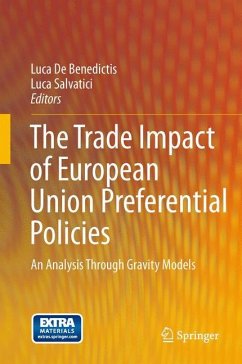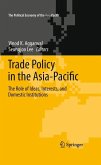This thorough inquiry into the EU's preferential trade policies finds that the delivery of the schemes' aims has varied. The book takes an eclectic but rigorous approach to analyzing the econometrics by combining different specifications of the gravity model.
The book investigates the EU preferential trade policy and, in particular, the impact it had on trade flows from developing countries. It shows that the capability of the "trade as aid" model to deliver its expected benefits to these countries crucially differs between preferential schemes and sectors. The book takes an eclectic but rigorous approach to the econometric analysis by combining different specifications of the gravity model. An in-depth presentation of the gravity model is also included, providing significant insights into the distinctive features of this technique and its state-of-art implementation. The evidence produced in the book is extensively applied to the analysis of the EU preferential policies with substantial suggestions for future improvement. Additional electronic material to replicate the book's analysis (datasets and Gams and Stata 9.0 routines) can be found in the Extra Materials menu on the website of the book.
Hinweis: Dieser Artikel kann nur an eine deutsche Lieferadresse ausgeliefert werden.
The book investigates the EU preferential trade policy and, in particular, the impact it had on trade flows from developing countries. It shows that the capability of the "trade as aid" model to deliver its expected benefits to these countries crucially differs between preferential schemes and sectors. The book takes an eclectic but rigorous approach to the econometric analysis by combining different specifications of the gravity model. An in-depth presentation of the gravity model is also included, providing significant insights into the distinctive features of this technique and its state-of-art implementation. The evidence produced in the book is extensively applied to the analysis of the EU preferential policies with substantial suggestions for future improvement. Additional electronic material to replicate the book's analysis (datasets and Gams and Stata 9.0 routines) can be found in the Extra Materials menu on the website of the book.
Hinweis: Dieser Artikel kann nur an eine deutsche Lieferadresse ausgeliefert werden.
From the reviews:
"This book concentrates on the first of these objectives by looking at the trade effects of the European Union's GSP as well as other regimes of EU trade preferences for LDCs. ... the volume might deserve a place in reading lists for courses in applied trade policy, particularly since Springer offers data and STATA code used in the applications as extra online material." (Wilhelm Kohler, Journal of Economics and Statistics, Vol. 232 (6), November, 2012)
"This book brings together work from numerous authors covering European Union (EU) trade policies towards developing countries and the empirical study of their effect on trade flows. ... The path chosen can speak to several kinds of readers, interested in the policies themselves and empirical results of their effects, or looking for guidance in econometric gravity model applications. ... a welcome addition for some readers who wish to investigate the data further, and can be a good primer for futureresearch." (Martin Clever, European Review of Agricultural Economics, Vol. 39 (3), July, 2012)
"This book concentrates on the first of these objectives by looking at the trade effects of the European Union's GSP as well as other regimes of EU trade preferences for LDCs. ... the volume might deserve a place in reading lists for courses in applied trade policy, particularly since Springer offers data and STATA code used in the applications as extra online material." (Wilhelm Kohler, Journal of Economics and Statistics, Vol. 232 (6), November, 2012)
"This book brings together work from numerous authors covering European Union (EU) trade policies towards developing countries and the empirical study of their effect on trade flows. ... The path chosen can speak to several kinds of readers, interested in the policies themselves and empirical results of their effects, or looking for guidance in econometric gravity model applications. ... a welcome addition for some readers who wish to investigate the data further, and can be a good primer for futureresearch." (Martin Clever, European Review of Agricultural Economics, Vol. 39 (3), July, 2012)








